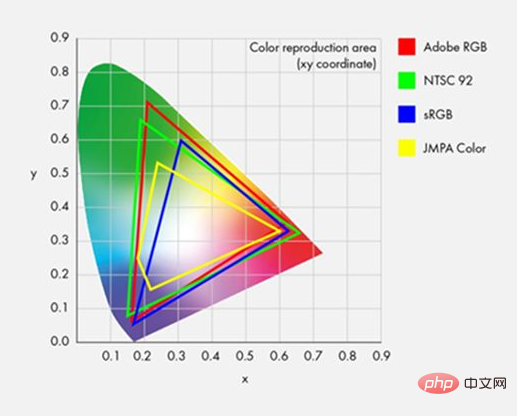
The difference between srgb and adobe rgb: 1. The sRGB color gamut is a universal standard color gamut, while Adobe RGB is a practical color space proposed by Adobe in 1998; 2. The AdobeRGB color gamut covers a wide range. In comparison, sRGB has a wider range of applications.

#The operating environment of this article: Windows 7 system, Dell G3 computer.
The difference between srgb and adobe rgb:
1. sRGB is different from Adobe RGB development manufacturers
The sRGB color gamut is one The universal standard color gamut is a standard color space developed by Microsoft and HP. It is intended to allow various computer peripheral devices and application software such as monitors, digital cameras, scanners, and projectors to have a common language for color. The larger the sRGB range that the display device can cover, the richer and fuller the displayed colors will be.
Adobe RGB is a practical color space proposed by Adobe in 1998. It is suitable for simulating printing colors and has been widely used in the printing field.
2. The color gamut coverage of sRGB and Adobe RGB is different

As can be seen in the above picture, the blue triangle part is covered by sRGB Range, the red triangle part is the AdobeRGB color gamut coverage, and the yellow trapezoid part is the common printing color standard.
It can be seen that 100�obeRGB has a wider range than 100%sRGB, including the CMYK color space that is not fully covered by sRGB, covering larger green and cyan areas, and can be more realistic Accurately restore photographic objects (such as sky, grass, etc.) and record more color details. The AdobeRGB color gamut allows greater freedom in image processing and editing.
3. sRGB and Adobe RGB are suitable for different people
Although AdobeRGB has a wider color gamut coverage, not everyone needs to use a display device that supports Adobe RGB Just fine. In comparison, sRGB has a wider range of applications. sRGB is the universal color standard for Windows systems and most browsers.
“sRGB” (standard Red Green Blue) means “standard RGB color space”. The default color space of scanners, low-end printers and other hardware and many software is sRGB, which facilitates mutual simulation of colors. We sometimes encounter that after uploading a picture in the Adobe RGB color gamut to a website that does not support color management, the color of the picture becomes dull. This is because the color information in the picture that exceeds the limit of the browser's color rendering range is lost.
So, if you usually only take photos to browse and use on the Internet platform, and rarely do color management work, since projectors and most display screens use the sRGB standard, you can directly Select sRGB mode. For example, the SLR camera manual posted by friend LINCOLN also says: "If you are not very familiar with Adobe RGB and color management, it is recommended to use sRGB."
For professional draftsmen and photographers who often need a wider color gamut for publishing, commercial printing, artistic creation, etc., or who cannot determine the purpose of the photographic work when shooting and need to preserve the image for a long time, in the camera Choosing to use the Adobe RGB color space can obtain better color gradation and be able to be expressed in printed matter.
In comparison, the application scenarios of AdobeRGB are narrow, and only when the entire process from camera-display-graphics card-image processing software-operating system-printer supports AdobeRGB can it be possible to achieve color management, ensuring that The image or color on different devices or media can achieve consistent results, producing a copy that is close to the original image or color.
The above is the detailed content of What is the difference between srgb and adobe rgb. For more information, please follow other related articles on the PHP Chinese website!




